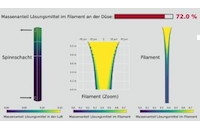Fraunhofer ITWM simulates and optimizes industrial Spinning Processes
CAE News |
 | Heat-resistant materials for aircraft turbines, hygiene articles and clothing are often made of polymer fibers: these in turn consist of numerous micrometer-thin filaments, which are twisted together. The filaments are produced by spinning processes - a process reminiscent of a spaghetti press. The polymer is first mixed with solvent to make it more viscous - i.e. liquid. This material is pressed through a spinning plate, a sort of sieve with thousands of micro-holes. The resulting wafer-thin filaments fall through a meters long funnel, where they are dry-blown with air or gas and thus freed of solvent. At the bottom of the funnel, the individual filaments are wound up on large rolls. So far, there was no way to simulate such spinning processes in their entirety - the processes are simply too complex, billions of smallest space cells would have to be simulated. If companies want to optimize their processes, it has hitherto been necessary to build a pilot plant costing several hundred thousand euros and to test for each of the countless parameters. More Information: itwm.fraunhofer.de/press |
